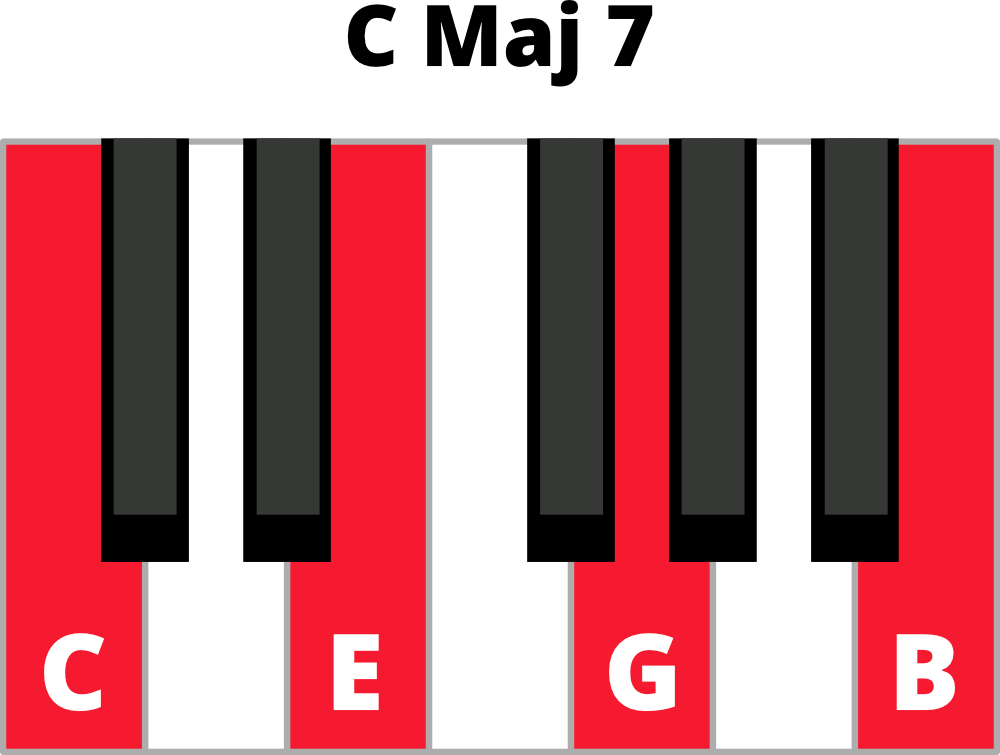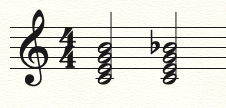AP Music Theory 🎶
72 resourcesSee Units
By using the triads we have just discovered, we can build seventh chords on top of them. Let's see how they work!

Seventh chords are chords that consist of four notes, with the fourth note being a seventh interval above the root note. Like triads, seventh chords are an important part of tonal harmony and are found in many different styles of music. There are several types of seventh chords, including major seventh chords, minor seventh chords, dominant seventh chords, diminished seventh chords, and half-diminished seventh chords.
A major seventh chord consists of a root note, a major third interval above the root, a perfect fifth interval above the root, and a major seventh interval above the root. It has a bright, happy sound and is often used to create a sense of resolution or closure in a piece of music. We might also write major seventh chords as MM chords, since there is a major triad followed by a major third.
Here is an example:

Image via PianoNote
A minor seventh chord (mm) consists of a root note, a minor third interval above the root, a perfect fifth interval above the root, and a minor seventh interval above the root. It has a more mellow, contemplative sound and is often used to create a sense of tension or dissonance.
A dominant seventh chord (Mm) consists of a root note, a major third interval above the root, a perfect fifth interval above the root, and a minor seventh interval above the root. It is one of the most common types of seventh chords and is used extensively in blues, jazz, and rock music. It has a strong, bluesy sound and is often used to create a sense of tension or instability that needs to be resolved.
A diminished seventh chord consists of a root note, a minor third interval above the root, a diminished fifth interval above the root, and a diminished seventh interval above the root. It has a very tense, dissonant sound and is used to create a sense of instability or unease.
The half-diminished seventh chord is similar to a diminished seventh chord, but with a minor seventh interval instead of a diminished seventh interval. Sometimes, we will denote seventh chords with a little circle and a line through it. It has a very tense, dissonant sound and is often used to create a sense of instability or unease in a piece of music.
The half-diminished seventh chord is often used as a substitute for a dominant seventh chord in jazz, and it is an important part of the harmonic language of the genre. It can also be found in classical music, where it is sometimes used to create a sense of tension or dissonance that needs to be resolved. In rock and pop music, the half-diminished seventh chord is not as common, but it can be used to add variety and interest to chord progressions and melodies.

Image via Music Theory Teacher
Seventh chords are typically played with the root note in the bass, or lowest part, and the other three notes stacked on top. Like triads, they can also be played in inversions, where the root note is not in the bass. In a first inversion seventh chord, the middle note (the third) is played in the bass, and in a second inversion seventh chord, the fifth is played in the bass. There is also a third inversion, where the seventh is played in the base, but this inversion is not used very frequently.
Diatonic Seventh Chords
Building a Seventh Chord in Major
First, let's take the base of a major triad and build seventh chords upon it. Let's use a C Major triad for now.

Reminder, a major chord is built by combining a major 3rd and a minor third above it. To make this triad into a Major 7th chord (MM or M7), we add a major 3rd on top. To make the triad a Major-minor 7th chord (Mm or dominant-7th), we add a minor 3rd on top.

What happens if the base triad is minor?

This minor triad can add a minor 3rd on top to create a minor 7th chord: mm

The last type of commonly used 7th chords contain the diminished triad base.

This base also can add a major or minor triad on top. Here is the diminished triad with a major 3rd on top. We call this a half-diminished seventh chord (ø7, dm, or diminished-minor).

If we add a minor triad to a diminished triad base, we have a fully-diminished seventh chord (°7, dd, or diminished-diminished)

On the major scale, all of the qualities of the seventh chords will be the same as the qualities of the triads. For a little bit of intuition about why this is the case, consider that the quality of the seventh chord depends on the quality of the triad and the quality of the third above the triad.
Now, let’s say that we take the three notes of the seventh chord that do not include the root. This will be a three chord in whatever key the root is in. If the base triad is a major chord, then the third will be minor, so the interval between the third and the fifth (i.e. the fifth and the seventh in the original seventh chord) will also be major.
If the base triad is a minor chord, then the third will be Major, so the interval between the fifth and the seventh will be minor.
The only chord that this doesn’t work for is the V chord, because a third above the fifth is the octave. In this case, you will have a Major-minor seventh chord (aka a dominant seventh chord). See where the name “dominant seventh chord” comes from?
The other chord that will be a little bit different in Major is the seven chord. Its base triad will be diminished, and following the observations above, the third between the fifth and the seventh is minor. Therefore, it is not fully diminished – it will just be half-diminished.
Just to recap, here are the scale degrees and the corresponding qualities of the seventh chords. The chords built on the first, fourth, and fifth scale degrees are major chords, and the chords built on the second, third, and sixth scale degrees are minor chords. The chord built on the seventh scale degree is a diminished chord.
For example, in the key of C major, the diatonic seventh chords are C major seventh (I), D minor seventh (ii), E minor seventh (iii), F major seventh (IV), G dominant seventh (V), A minor seventh (vi), and B half-diminished seventh (viiø).
Diatonic Seventh Chords in Minor
When we are writing in minor, the diatonic seventh chords will have different qualities. Unlike in the last section, the seventh chords will not always have the same qualities as the triads. This is because we have to consider raising the 7th in some instances (e.g. to make the V a major chord).
The chords built on the first and fourth scale degrees are minor chords, and the chords built on the third, and seventh scale degrees are major chords. The chord built on the third scale degree is a diminished chord.
For example, in the key of A minor, the diatonic seventh chords are A minor seventh (i), B half-diminished seventh (iiø), C major seventh (III), D minor seventh (iv), E major seventh (V), F major seventh (VI), and G major seventh (vii°).
Notice that just like when we learned triads, we raise the seventh when we write the dominant chord and the vii chord, but not for the i chord or the III chord. We usually don’t raise the sixth because the raised sixth has a melodic function – not a harmonic function.
🦜 Polly wants a progress tracker: Can you spell a gø7 chord (G half-diminished 7th chord)?
Using Seventh Chords in Chord Progressions
In classical styles, we only really see the seventh chord built on the 2nd, 5th, and 7th scale degrees. One example is the V⁷ chord, which allows us to use stepwise motion and resolve beautifully towards the tonic.
Seventh chords generally have a lot of dissonance, because there is the dissonant 7th interval in the chord. As such, seventh chords can be used in chord progressions to create a sense of instability or dissonance. For example, a half-diminished seventh chord can be used to create a sense of tension or dissonance that is not fully resolved until later in the progression.
Seventh chords are also good to use as substitutes for other chords in chord progressions when the voice leading is awkward or there are large leaps. Remember: we want stepwise motion whenever possible, so we can use seventh chords to achieve that goal. We will see how all of these functions work in more detail in future chapters.
Browse Study Guides By Unit
🎵Unit 1 – Music Fundamentals I (Pitch, Major Scales and Key Signatures, Rhythm, Meter, and Expressive Elements)
🎶Unit 2 – Music Fundamentals II (Minor Scales and Key Signatures, Melody, Timbre, and Texture)
🎻Unit 3 – Music Fundamentals III (Triads and Seventh Chords)
🎹Unit 4 – Harmony and Voice Leading I (Chord Function, Cadence, and Phrase)
🎸Unit 5: Harmony and Voice Leading II: Chord Progressions and Predominant Function
🎺Unit 6 – Harmony and Voice Leading III (Embellishments, Motives, and Melodic Devices)
🎤Unit 7 – Harmony and Voice Leading IV (Secondary Function)
🎷Unit 8 – Modes & Form
🧐Exam Skills
📚Study Tools

Fiveable
Resources
© 2025 Fiveable Inc. All rights reserved.